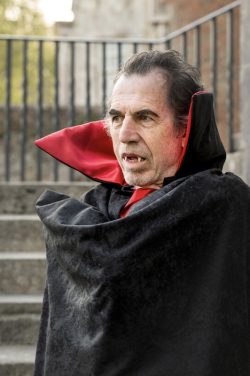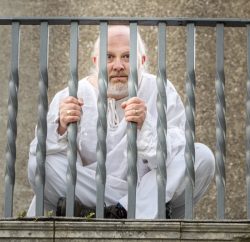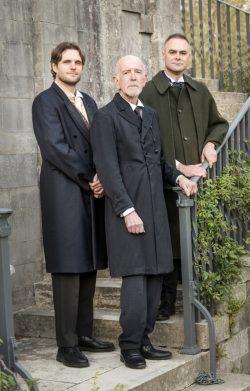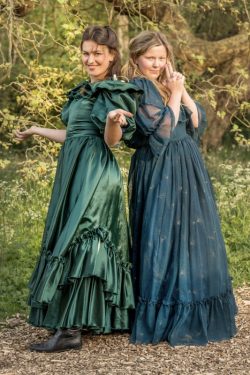 WHAT is it about the story of Dracula that continues to grip us? Whether it is the 1897 original Bram Stoker novel, the high camp of Hammer horror movies, the dark charisma of the Mark Bruce Dance Company version or any of the stage adaptations, this gothic tale exerts a peculiar fascination.
WHAT is it about the story of Dracula that continues to grip us? Whether it is the 1897 original Bram Stoker novel, the high camp of Hammer horror movies, the dark charisma of the Mark Bruce Dance Company version or any of the stage adaptations, this gothic tale exerts a peculiar fascination.
One answer, suggested by Count Dracula himself in Richard M Sharpe’s 1980 play, is that ordinary men do not understand women, their power, their intelligence and their independent spirit. Perhaps there was more than a little truth in this, if you consider the doll-like model of perfect young womanhood in the late Victorian period in which Stoker lived and wrote. The tragic figure of Lucy Westenra, the Count’s first victim in this version and already dead as the play opens, is the Victorian male’s “ideal” – beautiful, flirtatious, superficially subservient. He friend, the brave, intelligent Mina, is a very different and much more “modern” young woman.
Studio Theatre chose Sharpe’s retelling of the story of the Transylvanian nobleman, doomed to live forever, periodically rejuvenated by the blood of a beautiful young woman – a shadowy figure of unimaginable psychological and physical power, living in the shadows and hiding during daylight hours.
From his first entry, to greet the hapless Jonathan Harker (Matthew Hodge), Paul Chambers inhabits the central role with real presence, his Gandalf-like long grey hair framing his intelligent but inscrutable face, a sophisticated host but a ruthless master, sending his (undead) female protégées scuttling back to their quarters, ready to feast on a new-born baby.
 For the story of Dracula to work, you have to believe in the forcefield of charisma around the central figure. You don’t have to believe in the idea of the undead, or even know about the Count’s legendary ancestor, the monstrous tyrant Count Vlad “the Impaler.” You have to accept the premise that this bestial creature, who sinks his lascivious teeth into the slender throat of a sleeping woman, draws the victim to him as he sucks out her life-blood. It’s a chillingly powerful metaphor for male supremacy!
For the story of Dracula to work, you have to believe in the forcefield of charisma around the central figure. You don’t have to believe in the idea of the undead, or even know about the Count’s legendary ancestor, the monstrous tyrant Count Vlad “the Impaler.” You have to accept the premise that this bestial creature, who sinks his lascivious teeth into the slender throat of a sleeping woman, draws the victim to him as he sucks out her life-blood. It’s a chillingly powerful metaphor for male supremacy!
 Sharpe’s version plays the story straight – there are no laughs, no moments of high camp glamour or silliness. This is a tale of good versus evil, of the battle between a figure of ancestral, superhuman power and people of faith and courage. As such, it is timeless.
Sharpe’s version plays the story straight – there are no laughs, no moments of high camp glamour or silliness. This is a tale of good versus evil, of the battle between a figure of ancestral, superhuman power and people of faith and courage. As such, it is timeless.
The play also brings much more to the fore the role of the pathetic Renfield (a marvellously twitchy, jumpy performance by Simon Haseley). Here the madman is a creature utterly subject to Dracula’s power, but an inner core of humanity lurks within, well-depicted in this characterisation.
As the two young women, close friends but very different in character, Martha-Rose McKeown captures the flighty charm and tragic destiny of Lucy, while Martha Osment, returning to Studio Theatre after a nine-year hiatus, is convincing as the brave, intelligent and independent Mina.
Matthew Hodge’s Harker is a sensible young man, caught up in a web of cruelty, corruption and evil beyond his Victorian middle class comprehension. His friend, and Lucy’s fiancé, Dr John Seward (Andrew Hall, capturing the torment of a professional scientist drawn into a supernatural underworld), is trying to bring more compassionate treatment to people considered insane – but forced to confront the impossible reality of Dracula.
 Central to the struggle to destroy the Count is the rather mysterious Dr van Helsing, a man of science and learning, whose deep Christian faith allows him to grapple with the challenge of true evil. Alistair Faulkner, maintaining a credable Dutch accent throughout, captures the intelligence and strength of this pivotal character.
Central to the struggle to destroy the Count is the rather mysterious Dr van Helsing, a man of science and learning, whose deep Christian faith allows him to grapple with the challenge of true evil. Alistair Faulkner, maintaining a credable Dutch accent throughout, captures the intelligence and strength of this pivotal character.
Whether they are Sharpe’s creation, or director Linda Hayman’s idea, the presence of six black-clad figures with claw-like hands and making weird bird-like noises, provides a constant on-stage presence, as harbingers of death, Dracula’s henchmen – and stage furniture-movers. These are the Nosferatu – apparently an ancient Romanian word for vampire.
They are a fearful and atmospheric presence. If there is a criticism of this richly visual and dramatic production, it is that the scene-changing is quite slow, albeit accompanied by well-chosen music. But that slowness creates its own tension, contributing to the almost hypnotic power of the story.
Congratulations to everyone involved in this darkly enjoyable show, including the atmospheric back-projections and the splendid costumes.
FC
Photographs of the principals, including the “rejuvenated” Dracula, taken at Mottisfont Abbey by Anthony von Roretz, Trinity Photography